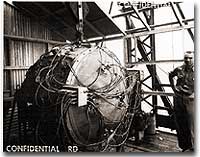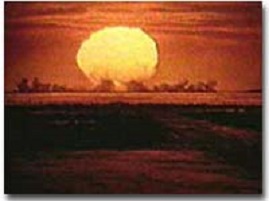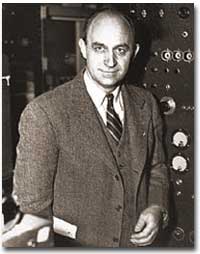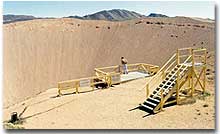51f. The Manhattan Project

This once classified photograph features the first atomic bomb — a weapon that atomic scientists had nicknamed "Gadget." The nuclear age began on July 16, 1945, when it was detonated in the New Mexico desert.
Early in 1939, the world's scientific community discovered that German physicists had learned the secrets of splitting a uranium atom. Fears soon spread over the possibility of Nazi scientists utilizing that energy to produce a bomb capable of unspeakable destruction.
Scientists Albert Einstein, who fled Nazi persecution, and Enrico Fermi, who escaped Fascist Italy, were now living in the United States. They agreed that the President must be informed of the dangers of atomic technology in the hands of the Axis powers. Fermi traveled to Washington in March to express his concerns to government officials. But few shared his uneasiness.

Leaving nothing to chance, Los Alamos atomic scientists conducted a pre-test test in May 1945 to check the monitoring instruments. A 100-ton bomb was exploded some 800 yards from the Trinity site where Gadget would be detonated a few weeks later.
Einstein penned a letter to President Roosevelt urging the development of an atomic research program later that year. Roosevelt saw neither the necessity nor the utility for such a project, but agreed to proceed slowly. In late 1941, the American effort to design and build an atomic bomb received its code name — the Manhattan Project.
At first the research was based at only a few universities — Columbia University, the University of Chicago and the University of California at Berkeley. A breakthrough occurred in December 1942 when Fermi led a group of physicists to produce the first controlled nuclear chain reaction under the grandstands of Stagg Field at the University of Chicago.

Enrico Fermi, a physicist who left fascist Italy for America, encouraged the U.S. to begin atomic research. The result was the top-secret "Manhattan Project."
After this milestone, funds were allocated more freely, and the project advanced at breakneck speed. Nuclear facilities were built at Oak Ridge, Tennessee and Hanford, Washington. The main assembly plant was built at Los Alamos, New Mexico. Robert Oppenheimer was put in charge of putting the pieces together at Los Alamos. After the final bill was tallied, nearly $2 billion had been spent on research and development of the atomic bomb. The Manhattan Project employed over 120,000 Americans.
Secrecy was paramount. Neither the Germans nor the Japanese could learn of the project. Roosevelt and Churchill also agreed that Stalin would be kept in the dark. Consequently, there was no public awareness or debate. Keeping 120,000 people quiet would be impossible; therefore only a small privileged cadre of inner scientists and officials knew about the atomic bomb's development. In fact, Vice-President Truman had never heard of the Manhattan Project until he became President Truman.
Although the Axis powers remained unaware of the efforts at Los Alamos, American leaders later learned that a Soviet spy named Klaus Fuchs had penetrated the inner circle of scientists.

This crater in the Nevada desert was created by a 104 kiloton nuclear bomb buried 635 feet beneath the surface. It is the result of a 1962 test investigating whether nuclear weapons could be used to excavate canals and harbors.
By the summer of 1945, Oppenheimer was ready to test the first bomb. On July 16, 1945, at Trinity Site near Alamogordo, New Mexico, scientists of the Manhattan Project readied themselves to watch the detonation of the world's first atomic bomb. The device was affixed to a 100-foot tower and discharged just before dawn. No one was properly prepared for the result.
A blinding flash visible for 200 miles lit up the morning sky. A mushroom cloud reached 40,000 feet, blowing out windows of civilian homes up to 100 miles away. When the cloud returned to earth it created a half-mile wide crater metamorphosing sand into glass. A bogus cover-up story was quickly released, explaining that a huge ammunition dump had just exploded in the desert. Soon word reached President Truman in Potsdam, Germany that the project was successful.
The world had entered the nuclear age.







